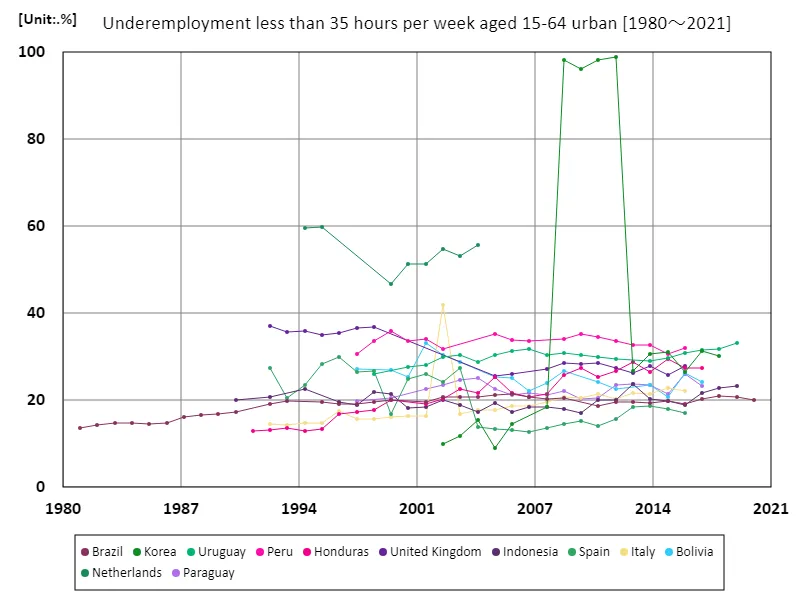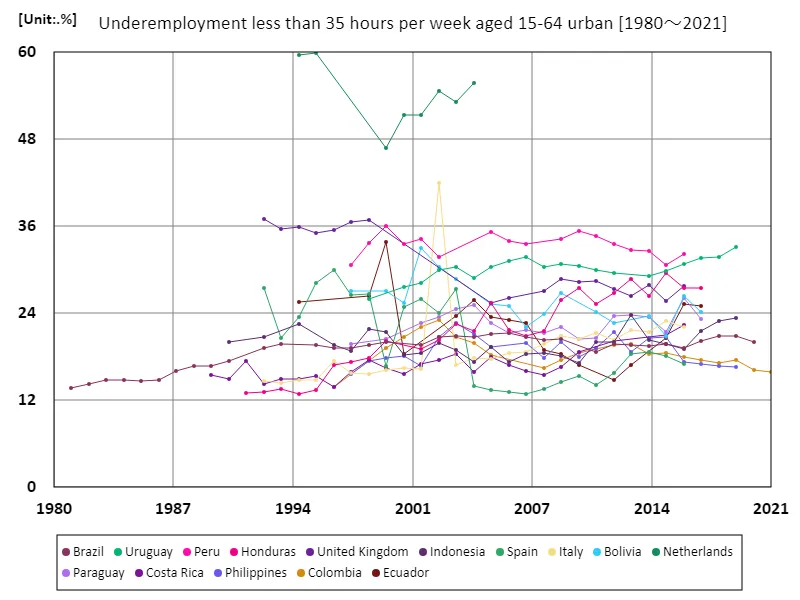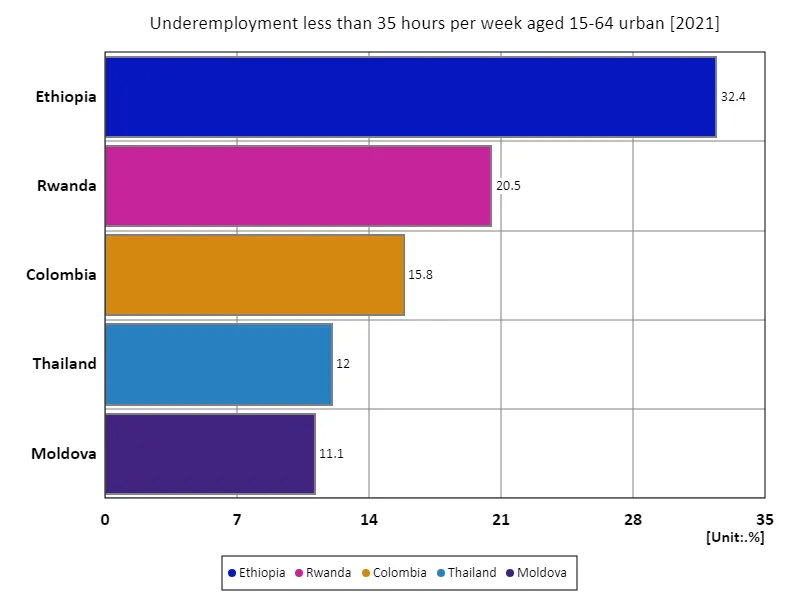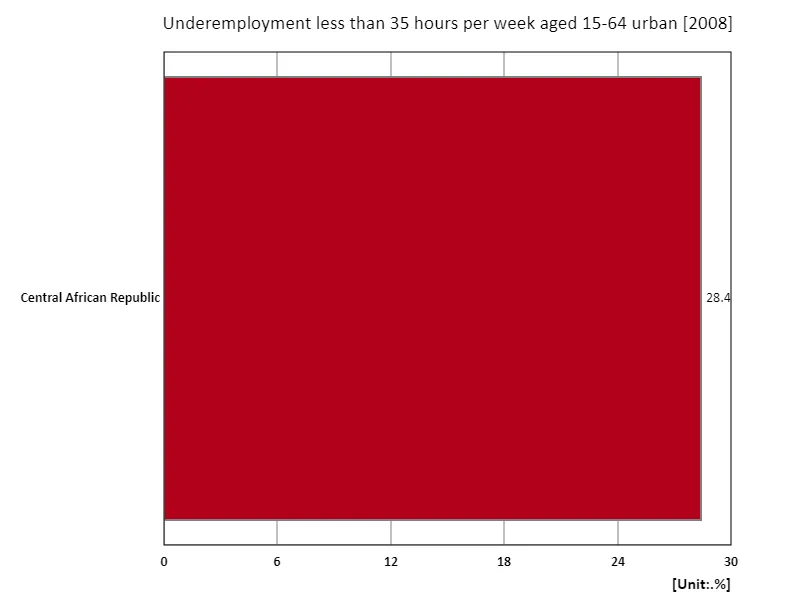- Abstract
- Ages 15-64, underemployed less than 35 hours per week, urban areas (ratio of working-age urban employed population)
- Ages 15-64, underemployed (less than 35 hours per week), urban areas (ratio of working-age urban employment population) (Worldwide)
- Ages 15-64, underemployed (
- Ages 15-64, underemployed less than 35 hours per week, urban areas (ratio of working-age urban employment population) (region, latest year)
- Reference
Abstract
Employment underemployment is a key indicator of an economy’s health and is a particularly salient challenge in emerging market economies like Brazil. According to 2020 data, the underemployment rate for 15-64 year olds working less than 35 hours a week has reached 20%, which is seen as an obstacle to long-term economic growth. In Brazil, informal and low-wage employment is on the rise, with the impact on the working-age population especially in urban areas. A trend over the past few years has been that the labor market has become even tougher due to the economic downturn and the pandemic, and more people are looking for stable employment. This phenomenon reflects economic instability and signals the need for governments and businesses to explore policies to create sustainable jobs. Ultimately, developing a comprehensive jobs strategy is essential for economic recovery.
Ages 15-64, underemployed less than 35 hours per week, urban areas (ratio of working-age urban employed population)
When analyzing data on underemployment from 1981 to 2020, the case of South Korea is particularly striking. In 2012, the underemployment rate reached 98.9%, an extreme figure by global standards. This high rate reflects the rapid increase in non-regular employment during the course of economic growth. Subsequently, South Korea’s rate fell to 30.5% in 2020 due to changes in its economic structure and improved employment policies. While this indicates a stabilization of the labor market, it also means that many people remain underemployed. Compared to other countries, South Korea’s underemployment rate fluctuates significantly and is particularly vulnerable to economic crises and structural reforms. Since the 1980s, globalization and technological innovation have made the labor market more flexible, but this has also ultimately led to an increase in non-regular employment. Many countries are currently working to diversify their labor markets and strengthen education in order to secure sustainable employment. The example of South Korea suggests that protecting workers’ rights amid economic growth is an important issue.


The maximum is 98.9%[2012] of Korea, and the current value is about 30.5%
Ages 15-64, underemployed (less than 35 hours per week), urban areas (ratio of working-age urban employment population) (Worldwide)
Between 1981 and 2021, underemployment of 15-64 year-olds less than 35 hours per week stood out in the case of South Korea, in particular. The underemployment rate of 98.9% recorded in 2012 is the result of rapid economic growth combined with an expansion in non-regular employment. This high rate indicates that it is difficult to secure stable employment in the pursuit of labor market flexibility. Since then, South Korea has carried out policy reforms and reviewed its economic structure, and by 2021 its underemployment rate had fallen to 30.5%. This shift shows how the labour market is adapting to increasing globalisation and digitalisation. Many countries face similar challenges and need to create sustainable jobs. Governments need to take action against underemployment, particularly among the working-age population in urban areas, as it has a direct impact on social stability and economic growth. Ultimately, the Korean case highlights the importance of maintaining flexible labor markets while protecting workers’ rights. Policies to adapt to changes in the labour market will be key to future economic sustainability.


The maximum is 59.9%[1995] of Netherlands, and the current value is about 93%
Ages 15-64, underemployed (
According to 2021 data, Ethiopia recorded the highest underemployment rate for 15-64 year olds working less than 35 hours a week at 32.4%, compared to an average of 18.4% and a total of 91.9%. Ethiopia’s high underemployment rate reflects its agriculture-centered employment structure during its economic development and the changes in the labor market that have accompanied urbanization. In particular, as migration from rural to urban areas progresses, non-regular employment is on the rise, and there are many people seeking stable employment, which is an issue. Moreover, the average underemployment rate of 18.4 percent highlights the reality that while many countries are diversifying their economies, they still struggle to provide stable employment. Particularly in developing countries, where education and skills shortages are an issue and labor market fluidity is increasing, the proportion of non-regular employment is on the rise. This situation suggests that sustainable job creation is important alongside economic growth. Governments and companies need to strengthen policies to protect workers’ rights and promote formal employment. Ultimately, having a stable employment environment will be essential for economic sustainability.


The maximum is 32.4% of Ethiopia, the average is 18.4%, and the total is 91.9%
Ages 15-64, underemployed less than 35 hours per week, urban areas (ratio of working-age urban employment population) (region, latest year)
According to 2008 data, the Central African Republic had the highest rate of underemployment for 15-64 year olds working less than 35 hours a week at 28.4%, while the overall average and total was also 28.4%. The figures reflect the Central African Republic’s economic instability and the impact of war and social unrest. High underemployment rates indicate a fragile labour market, meaning many people continue to lack stable employment. The 28.4% average also suggests that non-regular employment and precarious working conditions are widespread, especially in developing countries. Even in urban areas, as economic activity intensifies, the number of non-regular workers is increasing and formal employment opportunities are becoming limited. In this situation, as awareness of workers’ rights and treatment grows, ensuring sustainable employment becomes an important issue. Adaptation to the labor market is essential, especially as there is a demand for improved education and skills. Going forward, governments and businesses will need to strengthen policies to create stable jobs and improve workers’ living standards. This will lead to sustained economic growth.


The maximum is 28.4% of Central African Republic, the average is 28.4%, and the total is 28.4%



Comments